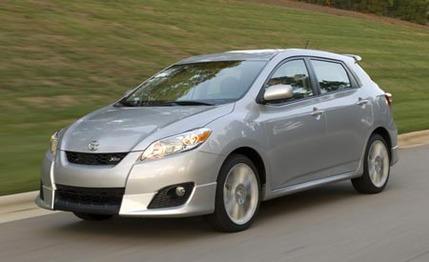
 First Drive Review
First Drive Review
We saw the cart before the horse, with teaser pictures of the all-new 2009 Pontiac Vibe hatchback being presented before Toyota released the official pictures and information on its ’09 Matrix, which more likely took the engineering lead for the two. Then the curtain came up on the Matrix at the 2007 SEMA show, followed weeks later by the Vibe at the 2007 Los Angeles auto show.
Now that we’ve driven the horse—before Pontiac got us behind the wheel of the Vibe—we can share a few things that are bound to be common driving characteristics between these completely redesigned crossovers.
Dull Styling
Although the Matrix and the Vibe might share underpinnings, the sheetmetal is, and has always been, unique to the competing brands. The look of the latest Matrix is intended to be sportier and more aggressive than before, and in some respects it is. But in its quest to add some sharpness and angularity to the Matrix, Toyota seems to have taken out the more interesting aspects of the previous model, and we find it to be rather less exciting than before.
Indeed, the 2009 Corolla looks like a size-smaller Camry, but the Matrix now looks more like a size- larger Scion xD, only duller, unless there is body cladding attached to it. The Vibe, on the other hand, looks better than ever, especially without body cladding. Wait, did we just say that?
The similarities between the Matrix and the Scion xD and Scion xB should hardly be a surprise, as there is little differentiation in their five-passenger tall-wagon program, high seating position, and powertrain choices. For its part, Toyota claims the Scions are intended to appeal to “urban trendsetters,” and the Matrix—like the new Corolla—is aimed at more “mainstream youth.” Then Toyota coughed up this somewhat surprising statistic: About one-third of all Scion intenders who choose not to get a Scion end up walking into the other showroom and picking out a Toyota. So maybe there is room
for both after all.
More Utility, Less Style
The Matrix will be available in three trims: Standard, S, and XRS. The interior of all three has bright white-lit gauges offsetting red-lit needles and a large, dominant speedometer. Everything from sport seats to the three-spoke steering wheel is new. However, much of the brightwork and interesting design of the prior Matrix have given way to cheaper, monotone materials, and thus, in spite of additional equipment and so-called upgraded fabrics, it’s hard to consider the new interior much of a step forward in design. By comparison, the Scions appear much more interesting. And cheaper, too.
But the Matrix is available with a lot of cool new bits, including Toyota’s latest navigation system with XM traffic reporting, a JBL audio system, and stability control (the latter available across all trim levels). Storage space, too, is impressive, with cubbies upon cubbies and a massive glove box. And in terms of safety, besides stability control, there are no options: Six airbags come standard.
Under the Skin
Under the hood, the Matrix Standard and the Matrix S share a new 1.8-liter, four-cylinder engine with the Corolla, generating 132 horsepower and 128 pound-feet of torque and featuring dual VVT-i (variable valve timing with intelligence). Unlike the Corolla, however, or any Scion, for that matter, the Matrix S is offered with all-wheel drive. The brakes, too, have been upgraded to four-wheel discs instead of the Corolla’s front-disc, rear-drum setup. Transmission choices are a five-speed manual or a four-speed automatic. Toyota says it expects at least 30 mpg from its new small cars, and the Matrix and the Vibe have both been engineered to accommodate a hybrid powertrain as well, which we expect to hear more about within a year or so.